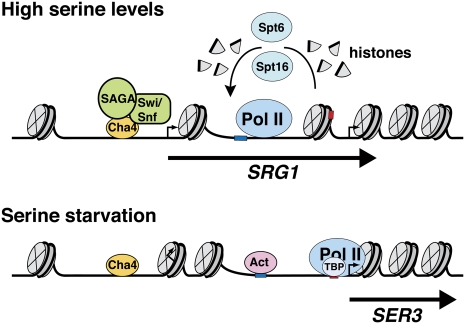Figure 7.
A model for SER3 regulation by SRG1 intergenic transcription. When serine is available to the cells, DNA-bound Cha4 recruits SAGA and Swi/Snf to initiate SRG1 transcription, possibly by remodeling the two nucleosomes located at the 5′ end of SRG1 to expose the SRG1 transcription start site. RNA Pol II transcribes SRG1 and, through Spt6 and Spt16, disassembles nucleosomes in its path and then reassembles them in its wake. As a result, nucleosomes continuously occupy the SER3 UAS where they repress SER3 by occluding the SER3 promoter from transcription factor binding. In the absence of serine, SRG1 transcription is repressed, possibly due to the presence of two nucleosomes at its 5′ end that encompass its transcription start site. In the absence of SRG1 transcription, the SER3 UAS is depleted of nucleosomes, allowing an as yet unknown activator (Act) and/or TBP and RNA Pol II to bind and activate SER3 transcription.

